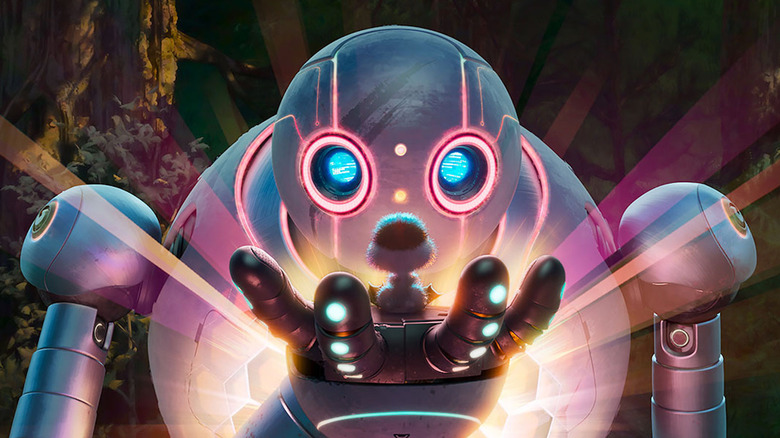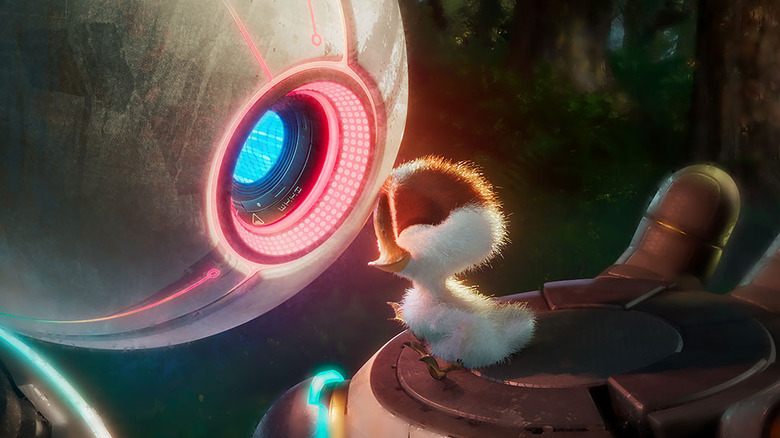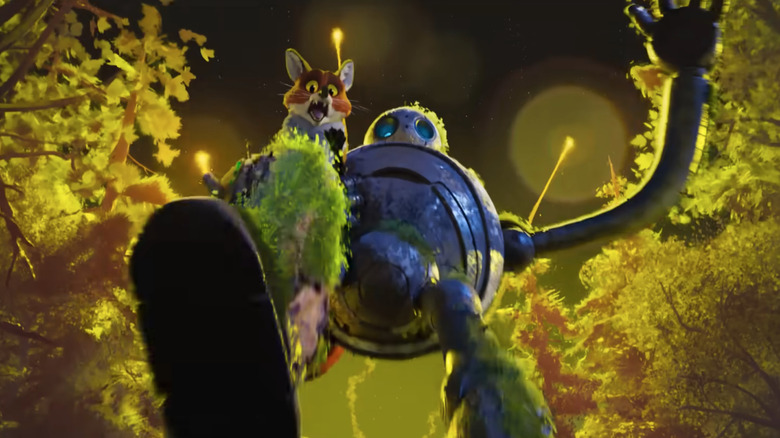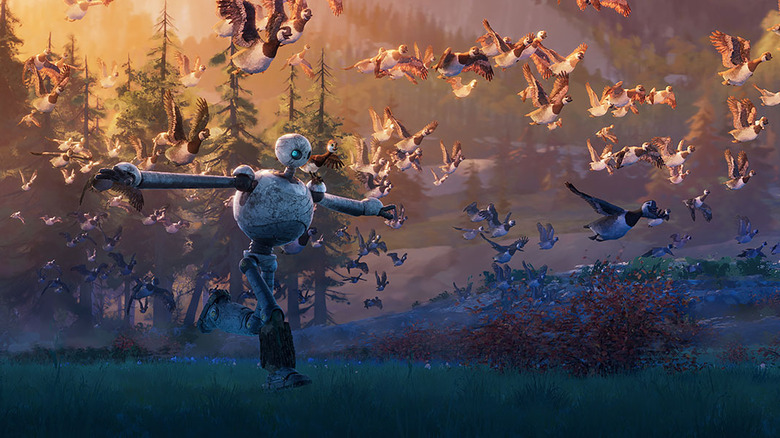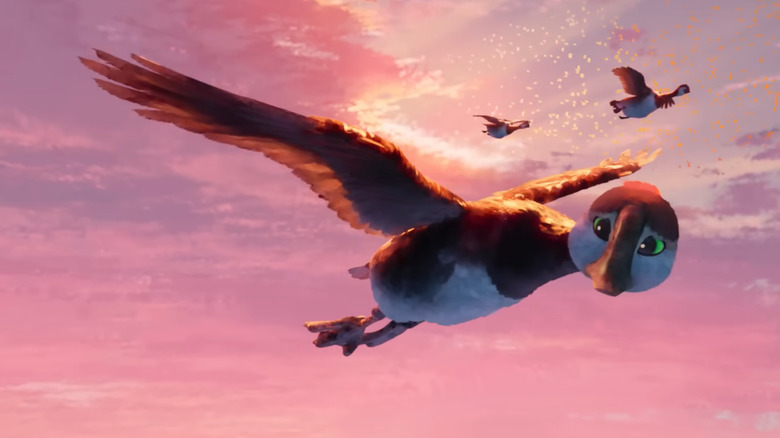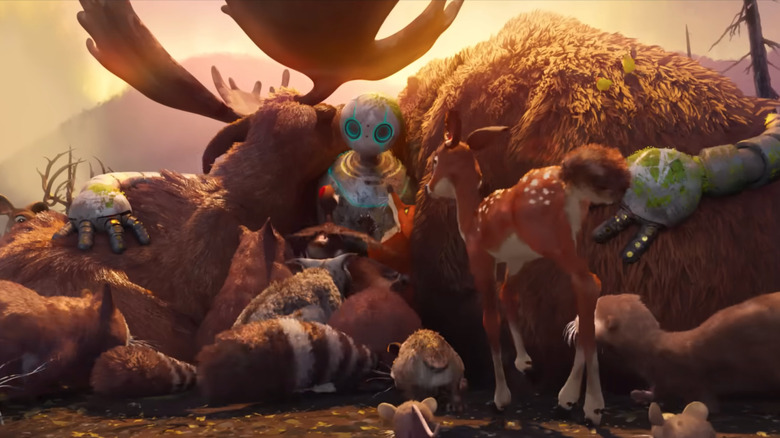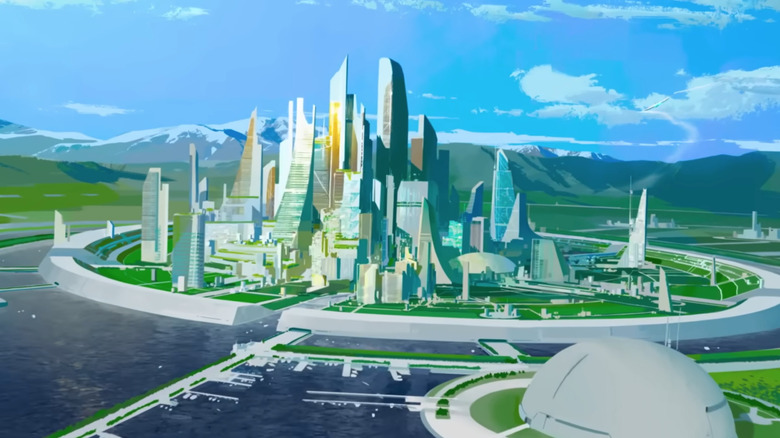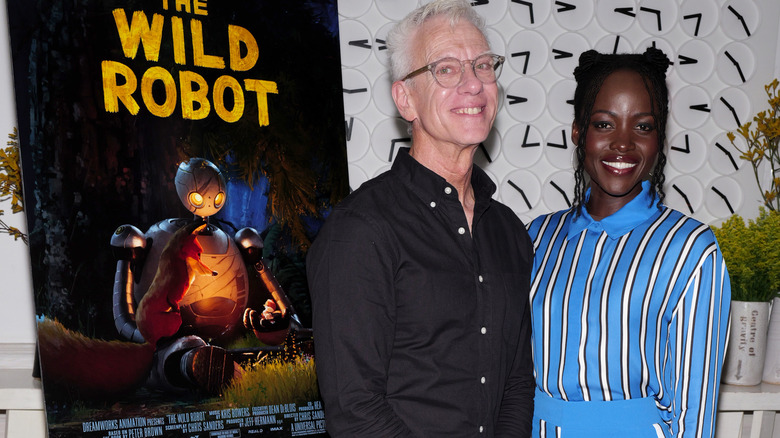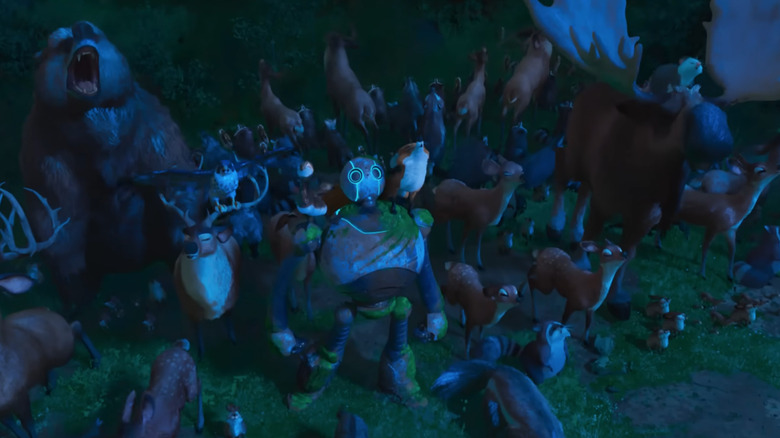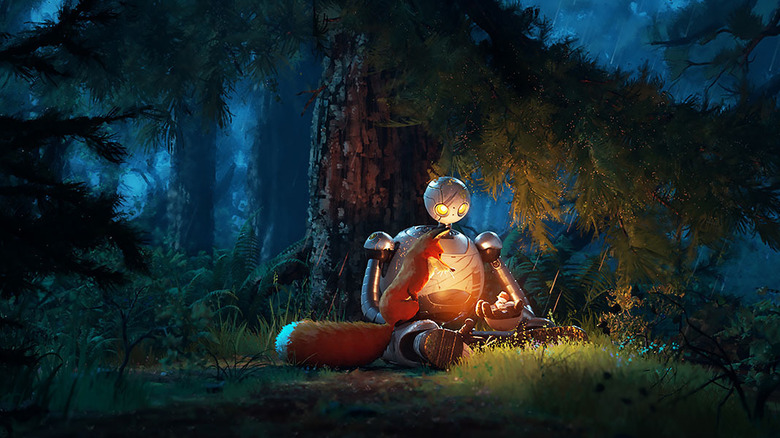The Ending Of The Wild Robot Explained
Contains spoilers for "The Wild Robot"
"The Wild Robot," based on the popular children's book by Peter Brown and adapted for the screen by animation legend Chris Sanders, arrives just in time for the 30th anniversary of the founding of DreamWorks Animation. On a sadder note, it's also the last film the studio made completely in-house before severe downsizing, but the artists who worked on it should take pride in crafting one of the most beautiful works of computer animation ever produced — and one that will certainly land on the list of best animated movies of 2024.
The ending to this story of motherhood and growing beyond one's "programming" plays out mostly in the ways you'll expect, but with just enough surprises to keep you excited, and told in such a skillful fashion that you'll want to bring tissues to the theater. Once you've finished crying and calling your moms, here's some more detailed analysis of what the ending of "The Wild Robot" means for all of its characters, the potential for sequels, and why it hits as hard as it does, with insights from director Chris Sanders and voice actress Lupita Nyong'o on the secrets of the film's artistic success.
What you need to remember about the plot of The Wild Robot
At the start of "The Wild Robot," the ROZZUM Unit 7134 helper robot, aka "Roz" (Lupita Nyong'o), is activated in the wilderness by accident. She seeks an assignment to help out her new animal companions, but she can't understand them, and they see her as a monster. Roz studies the animals, learning to imitate their movements and understand their languages, but still feeling unwanted, she tries contacting her manufacturer for retrieval. This goes wrong, and the ensuing accident kills a goose and destroys all but one of its eggs. She decides to protect that egg from the hungry fox Fink (Pedro Pascal), and when it hatches, the gosling won't leave her alone.
Roz is stuck with the child, and after it breaks her communications module, she's stranded in the forest with it. Pinktail (Catherine O'Hara), an opossum currently raising seven kids, frames motherhood for Roz as a three-part assignment she can process: making sure the kid can eat, swim, and fly in time for the fall migration. Fink gives Roz advice on feeding the gosling while taking advantage of her naïveté to get a bunch of meals out of it himself. While Roz builds a shelter, Fink also gives her the suggestion to give the kid a name. She chooses Brightbill.
As the months pass and Brightbill (Kit Connor) grows up, he struggles with swimming and has zero confidence in flying. He's a runt, a social outcast, and the other geese bully him. Learning about his family's death strains things with Roz, but the goose leader Longneck (Bill Nighy) helps them reconcile, and with additional help from the falcon Thunderbolt (Ving Rhames), Brightbill learns to fly.
What happened at the end of The Wild Robot?
With her mission completed, Roz realizes that motherhood has changed her programming. Even with a new communication module recovered from a destroyed ROZZUM unit, she chooses to wait instead for Brightbill's return in the spring. She brings all the other animals to her shelter, and before entering hibernation mode for the winter, she convinces the animals to form a truce and agree not to eat each other so that they can all survive a coming storm.
Meanwhile, on their migration path, the geese have discovered the gated community where Roz came from — and these perfection-obsessed humans don't want the geese around. The flock needs Brightbill, who understands robots, to keep them safe, and Longneck makes a heroic sacrifice to help their escape plan succeed. Roz reawakens just as the geese return. Another Universal Dynamics robot, Vontra (Stephanie Hsu), arrives to take Roz away for study — and when Roz decides not to leave, Vontra sends more robots to attack the forest. Roz and the animals fight back, but Vontra makes the attack-bots self-destruct and start a forest fire while Roz gets abducted.
The animals put out the fire with the help of Paddler (Matt Berry), a beaver whose ambitions to fell the forest's largest tree end up saving the day. Brightbill leads the geese to destoy Vontra and rescue Roz. Though Roz appears to have her mind wiped, Brightbill tells his mom he loves her, awakening the memories in her heart. Knowing that Universal Dynamics will keep going after her, Roz chooses to turn herself in, assuring Brightbill she won't forget him. Sure enough, when the geese return to the human compound next migration season, Brightbill reawakens Roz's motherly side once again.
What the ending means for Roz
Like some of the best robot movies of all time, such as "The Iron Giant" (an animated box office bomb worth watching) and "WALL-E," Roz's arc in "The Wild Robot" is about the ability to change one's "programming." Roz isn't a weapon like the Iron Giant or a single-use tool like WALL-E, and much of what she's programmed for — friendliness, helping others — remains valuable throughout. But her purpose evolves from merely doing what is asked of her to being able to make her own decisions, rebelling against the company that made her in order to protect those she's come to care about.
Roz stands out from other animated androids in that her development is spurred on by becoming an adoptive mother. It's a huge responsibility she doesn't believe she can handle at first, but in raising, teaching, and protecting Brightbill, she proves more adaptable than she ever believed possible. Even actions she's flat-out incapable of at the beginning of the film — lying and detecting lies, for instance — she eventually figures out and puts to use for a good purpose.
While Roz initially cares from Brightbill out of a mix of guilt and unavoidability, true maternal love becomes her primary motivation by the end. This love saves her repeatedly in the final act, becoming powerful enough that her heart remembers even if her head gets damaged or reset. (Though on a sillier note, where is her "heart" exactly?)
Brightbill's story may mean more than you think
Growing from a hatchling to the leader of his flock, Brightbill experiences quite the dramatic coming of age over the course of "The Wild Robot." In his relationship with Roz, he goes from relying on her for everything as a baby, to questioning how and why she raised him as an adolescent, to ultimately saving her with his expression of love and appreciation for everything she did to make the best of a tragic situation.
One of Brightbill's main sources of friction with Roz — how being raised by a robot makes him different from the other geese — intersects with his conflict with the rest of the flock. That he does not "think like a goose" alienates him from his peers, until they all arrive at the human city and suddenly "not thinking like a goose" frees him from the panic faced by the other geese. It's a "Rudolph the Red-Nosed Reindeer" story, or an echo of Hiccup's arc in the first "How to Train Your Dragon" movie — the outsider becomes a leader thanks to the very differences that made them an outsider to begin with.
One can read Brightbill's story as a metaphor for disability. Canonically, he's physically disabled, a smaller goose who wouldn't have survived without Roz's care, and as such must find different techniques to adapt and learn how to fly. That such a big deal is made about how he thinks differently can also be read as a message about neurodiversity. He wouldn't be the first Chris Sanders character interpreted that way — many autistic viewers have interpreted Lilo from "Lilo and Stitch" as one of their own.
What the ending means for the animals
Stories anthropomorphizing both predators and prey can get into some complicated territory, especially if we're sympathizing with both sides. "The Wild Robot," for its part, doesn't shy away from the messiness of such subject matter — what was the last PG-rated family film to make this many casual jokes about death? — but works with it, managing to deliver a fairly nuanced message about togetherness in the face of disaster.
When Roz brings all the animals into her shelter and makes them form a truce, she doesn't deny that some of them have biological imperatives to eat one another. She just asks that they hold off until after the storm. If she can rewrite her own programming, then others can also challenge their evolutionary instincts. The movie isn't saying everyone can get along all the time — Fink the fox and Thorn the bear (Mark Hamill) aren't going vegan — but instead says that there are times when self-control and unlikely alliances are necessary for everyone's survival.
Director Chris Sanders spoke about these themes with Concrete Playground, saying, "The animals on this island have programming, and that's the way that Roz looks at it ... I thought that was a really interesting way to look at the world, and one of the load-bearing ideas and themes of the film is the idea that someday you may have to change your programming in order to survive."
Where do the humans fit into all this?
Based on the flying ships that deliver the ROZZUM units and the first glimpses of the futuristic city witnessed in informational videos, one might initially assume that humans have moved to other planets in the world of "The Wild Robot." But no, the city is inside a dome on Earth — and it sure looks as if humanity has mostly disappeared outside of these controlled communities. While the film doesn't belabor the point, the sight of the Golden Gate Bridge underwater as the geese go on their migration tells you all you need to know — that "The Wild Robot" takes place after a climate change apocalypse.
We don't get a sense of any humans as characters in this film, but based on their society's hostility to wildlife and anything deemed "imperfect," it feels like a safe assumption that they'll be filling antagonist roles in any potential follow-up films. But perhaps it's possible that Roz's kindness can change their society for the better, in the same manner she improved life for the animals?
What Chris Sanders and Lupita Nyong'o say about Roz's growth
Knowing how narratives about robots and mothers tend to play out, we all know the general direction Roz's story will take even without seeing the movie. It's the aspect of the film's ending that director Chris Sanders and voice actress Lupita Nyong'o have talked the most about in interviews ahead of release.
Sanders spoke with The Christian Post about how Roz's struggle to exceed her programming is relatable to all parents: "You'll face unexpected challenges, and sometimes you have to figure it out on the fly." Roz's success at raising her child inevitably leads to the difficulties of having to say goodbye, lending both an inevitability and an emotional intensity to what happens to Roz after she completes her mission. As the director put it, "Roz's success as a parent means letting go, and it's both beautiful and hard." This theme of letting go made Nyong'o cry so much that she had to call her mom.
Speaking to Concrete Playground about how she gradually humanized Roz's voice over the course of the film, Nyong'o described the process as "quite technical," elaborating, "We had certain markers, certain benchmarks for where the quality of my voice was shifting ... so it dials up in a way that when you're watching the performance is perhaps, hopefully, quite subtle and unnoticeable — until you meet the robots that are more like the other robots like her, towards the third act of the film."
Was there an alternate ending?
During the question and answer session following the second public screening of "The Wild Robot" at the 2024 Toronto International Film Festival, Chris Sanders was asked if it was always the plan for Roz to leave the wilderness and return to the human city for her animal friends' safety at the end of the film. Sanders answered that he knew the film had to end in this bittersweet fashion, both to stick with the ending of the first book and to stay true to the characters and themes.
He did, however, acknowledge that at some point in the production, he pitched a possible alternate ending where Roz chooses to stay in the forest — but not with the intention of this ending ever being made. He sensed such an idea might come up as a suggestion, so he tried to get ahead of that suggestion to show that it wouldn't work and that the actual ending played better.
Will there be a sequel?
Peter Brown's book "The Wild Robot" is the first in a trilogy, followed by "The Wild Robot Escapes" and "The Wild Robot Protects." Following the screening of "The Wild Robot" at the 2024 Toronto International Film Festival, Chris Sanders expressed a desire to adapt the full trilogy into a series of movies, should the first film perform well enough at the box office to justify the green light.
DreamWorks Animation is a very franchise-oriented studio — seven of the last 10 films the studio made before "The Wild Robot" have been sequels (here's every DreamWorks movie ranked from worst to best). So it makes sense they'd have an eye towards future follow-ups when developing "The Wild Robot." Sanders' two previous films for DreamWorks, "How to Train Your Dragon" and "The Croods," both launched successful franchises, though Sanders himself did not direct the sequels to either.
Assuming a sequel to "The Wild Robot" loosely follows the outline of "The Wild Robot Escapes," Roz will (you guessed it) make her escape from human society to return to her chosen home, encountering plenty of adventures with more animal friends and foes along the way.
